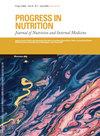Assessment of dietary intake of adolescent girls belonging to low socio economic status: a community based study from Lahore
4区 医学
Q4 Agricultural and Biological Sciences
引用次数: 3
Abstract
Aim: To assess the dietary intake and dietary habits of adolescent girls belonging to low socio economic status to provide a baseline data for future intervention studies, a community based descriptive analytical study was conducted. Method: Unmarried adolescent girls, who had had their first menarche, were selected through convenience sampling. Informed verbal consent was obtained from the participants and their parents. Three days dietary recall was used to gather dietary data which was analyzed according to recommended servings of food groups in MY PLATE (USDA, 2011) and through modified Healthy Eating Index (HEI) scoring. Means and percentages were calculated and the data was analyzed through SPSS version 17. Result: All the adolescents were consuming less than recommended calories for their age. More than 50% of adolescent girls were taking less than half the required calories. About 74 % adolescents were skipping one meal or another at least four times a week. Majority of adolescent girls80% were not con-suming even a single serving from fruit group. The mean HEI score was also very low (29/100) and fell into poor category. A strong correlation r=0.88 was found between HEI scores and caloric intake. Conclusion: Dietary intake of adolescent girls belonging to low socio economic status is far from satisfactory which does not meet the recommended diet for this age group. Intervention strategies are needed to improve the dietary intake of adolescent girls so that their requirements of energy along with other nutrients are met.社会经济地位低的少女膳食摄入量评估:来自拉合尔的一项基于社区的研究
目的:为了评估低社会经济地位少女的饮食摄入量和饮食习惯,为未来的干预研究提供基线数据,进行了一项基于社区的描述性分析研究。方法:采用方便抽样的方法,对初潮初潮的未婚少女进行选择。获得了参与者及其父母的知情口头同意。使用三天饮食回忆来收集饮食数据,这些数据根据MY PLATE(美国农业部,2011)中食物组的推荐份量和修改的健康饮食指数(HEI)评分进行分析。计算平均值和百分比,并通过SPSS 17版对数据进行分析。结果:所有的青少年摄入的热量都低于他们这个年龄段的推荐热量。超过50%的青春期女孩摄入的热量不到所需热量的一半。大约74%的青少年每周至少四次不吃一顿饭或另一顿饭。大多数青春期女孩80%的人甚至没有吃过一份水果。平均HEI得分也很低(29/100),属于较差类别。HEI评分与热量摄入之间存在很强的相关性,r=0.88。结论:低社会经济地位少女的膳食摄入远不能令人满意,不符合该年龄组的推荐饮食。需要采取干预策略来改善少女的饮食摄入,以满足她们对能量和其他营养素的需求。
本文章由计算机程序翻译,如有差异,请以英文原文为准。
求助全文
约1分钟内获得全文
求助全文
来源期刊

Progress in Nutrition
医学-营养学
CiteScore
1.40
自引率
0.00%
发文量
0
审稿时长
>12 weeks
期刊介绍:
Progress in Nutrition was founded in 1999 as an independent magazine, a multidisciplinary approach, dedicated to issues of nutrition and metabolism.
 求助内容:
求助内容: 应助结果提醒方式:
应助结果提醒方式:


